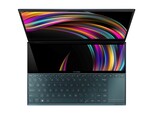Asus ZenBook Duo UX481FL
Specifications

Primary Camera: 0.9 MPix
Price comparison
Average of 6 scores (from 11 reviews)
Reviews for the Asus ZenBook Duo UX481FL
Asus wants to prove that there are other ways to innovate besides just creating the thinnest laptops year after year. The ScreenPad Plus display is both practical and invaluable when at its best, but it entails some ergonomic drawbacks.
Source: Ricks Tech

Single Review, online available, Medium, Date: 08/01/2022
Source: Ricks Tech

Support, online available, Very Long, Date: 07/20/2022
Source: Ricks Tech

Support, online available, Very Long, Date: 06/28/2022
Source: It Pro
 Archive.org version
Archive.org versionAsus has pushed boundaries with the UX481, and there are areas where this machine succeeds. The primary screen offers good quality for sRGB work, and the lower panel is useful for secondary apps. The Asus has smart looks, solid performance and superb battery life. In key areas, though, the daring design means uncomfortable compromise. The cramped keyboard and trackpad can’t compare to Dell and Apple’s offerings, and the Asus is thicker and heavier than rivals. If you’re going to use the secondary screen, then you may be able to accept these issues. If it’s not going to be integral to your work, though, conventional laptops remain better.
Single Review, online available, Long, Date: 06/13/2020
Rating: Total score: 60%
Source: Engadget
 Archive.org version
Archive.org versionThe ZenBook Duo is a solid attempt at delivering a dual-screen ultraportable. Using both screens is intuitive, and it can be genuinely practical for multitasking. But ASUS had to make compromises to fit those screens, especially when it comes to the keyboard and trackpad. It’s also heavier and thicker than any other ultraportable.
Single Review, online available, Long, Date: 06/11/2020
Rating: Total score: 81%
Source: Engadget
 Archive.org version
Archive.org versionIf you're considering the ZenBook Duo, the real question you need to ask yourself is how much do you really need two screens on a $1,499 ultraportable. ASUS did a decent job of fitting in a second display, but it leads to plenty of compromises.
Single Review, online available, Medium, Date: 06/10/2020
Source: The Verge
 Archive.org version
Archive.org versionBut if you’re looking specifically for a two-screen device, this one works. It’s more than a party trick; it’s useful and there are cool things you can do. But I think the form factor is better suited to a workstation (like the ZenBook Pro Duo) which is likely to spend most of its life at a desk with peripherals plugged in. I’m not sure if there’s a way to make a Duo that’s also good at being a portable laptop. If there is, Asus hasn’t quite found it.
Single Review, online available, Very Long, Date: 06/09/2020
Rating: Total score: 70%
Source: Trusted Reviews
 Archive.org version
Archive.org versionIf you’re going to benefit from the second screen – whether it’s in creative applications or just by bumping useful tools downwards – then the Duo is worth considering. If not, then more traditional notebooks remain better due to the number of design compromises Asus has had to make.
Single Review, online available, Long, Date: 05/18/2020
Rating: Total score: 70%
Source: Laptop Mag
 Archive.org version
Archive.org versionThe ZenBook Duo isn't as powerful as the ZenBook Pro Duo, but it delivers nearly all the same functionality at a significantly lower price. As a result, the Duo is a better option for all but the most demanding power users. First, you need to decide if the ZenBook Duo is right for you, or if a more traditional laptop, like the Samsung Galaxy Flex 15 or Lenovo Yoga C940 would be a better fit.
Single Review, online available, Very Long, Date: 05/16/2020
Rating: Total score: 80%
Foreign Reviews
Source: Mega Obzor
 RU→EN Archive.org version
RU→EN Archive.org versionPositive: Impressive dual display; powerful processor; elegant design; comfortable keyboard; light weight; nice performance. Negative: No USB-C; overheats while using.
Single Review, online available, Very Long, Date: 05/04/2020
Source: Zing
 VN→EN Archive.org version
VN→EN Archive.org versionPositive: Impressive dual display; powerful hardware; premium design; solid workmanship.
Single Review, online available, Long, Date: 09/16/2020
Comment
NVIDIA GeForce MX250: Successor of the MX150 and still based on the same Pascal GP108 chip (similar to the desktop GT 1030) but with higher clock speeds. Available in two versions, a normal 25 Watt version and a low power version with 10 Watt TDP and reduced performance. The 25 Watt version e.g. offers a 21% higher boost clock than the old MX150 leading to a 5% performance gain.
Modern games should be playable with these graphics cards at low settings and resolutions. Casual gamers may be happy with these cards.
» Further information can be found in our Comparison of Mobile Graphics Cards and the corresponding Benchmark List.
i7-10510U: Comet Lake based low power quad-core processor (technically identical to Whiskey Lake and still produced on 14nm++). The CPU cores can clock between 1.8 and 4.9 GHz (all 4 cores 4.3 GHz max.) with HyperThreading (8 threads). The integrated memory controller supports DDR4-2666 and using cTDP up/down the performance can be adjusted by the OEM (10 - 25 Watt possible, 15W default).» Further information can be found in our Comparison of Mobile Processsors.



